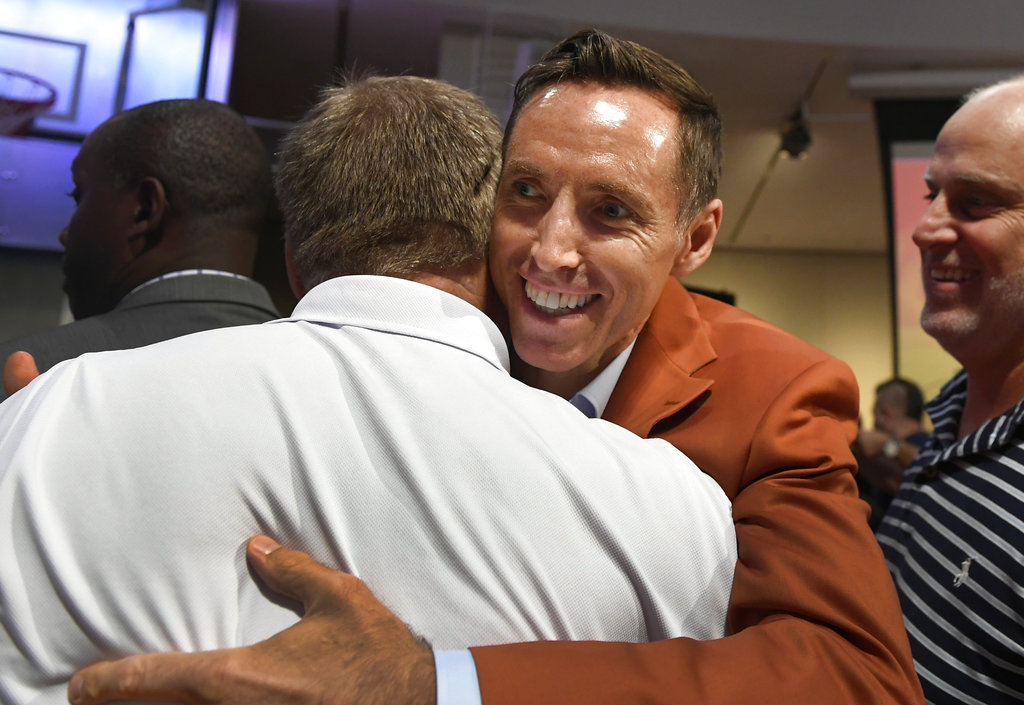Once an underdog, Nash enters Hall of Fame as innovator

Steve Nash, a class of 2018 inductee into the Basketball Hall of Fame, hugs fans after a news conference at the Naismith Memorial Basketball Hall of Fame, Thursday, Sept. 6, 2018, in Springfield, Mass. (AP Photo/Jessica Hill)
BOSTON — There were few times in Steve Nash’s basketball career when he wasn’t an underdog.
Before there were players like Stephen Curry and James Harden captivating NBA audiences with a free-wheeling, open-court style, Nash, a 6-foot-3 Canadian, was laying the groundwork for what would become the league’s “point guard era.”
From starring at St. Michaels High School in Victoria, British Columbia, to playing college ball at tiny Santa Clara, Nash was never supposed to an innovator in a game long dominated by much taller players.
But after spending nearly two decades in the NBA, becoming a two-time MVP, eight-time All-Star and one of its most creative passers along the way, it’s undeniable that Nash helped to remake both his position and the way it’s played by an entire generation today.
And when he’s inducted in the Naismith Basketball Hall of Fame on Friday, even the player described as “painfully humble” by former teammate Grant Hill won’t be able to deny his impact on the game.
“I recognize that it’s not a common list on someone’s resume,” Nash said.
Nash will be inducted by Don Nelson, the coach he blossomed under while playing in Dallas for six seasons, from 1998 to 2004. But he is equally thankful for the time he spent in the fast-paced offense of Mike D’Antoni in Phoenix, who coached the Suns when Nash won the first of his back-to-back league MVP honors in 2004-05 and 2005-06.
“I’m very grateful,” Nash said. “I played on some great teams with a great coach, and we had a great bond and we meshed very well and played at a very high level. Those were some of the best times of my life.”
Nash will share the stage with Hill, a teammate in Phoenix, as well as former Suns executive Rick Welts, now the president and chief operating officer of the Golden State Warriors.
Welts not only sees a lot of Nash in Curry, he also remembers how quickly Nash’s game went to a different level in Phoenix.
“You have to remember the Phoenix Suns won 29 games (in 2003-04) and traded their best player, Stephon Marbury, to the Knicks right before the July 1 signing of Steve Nash to a Suns’ contract,” Welts said. “And that 29-win team won 62 games the next year — still the biggest swing in the history of the NBA. So he and Mike D’Antoni reinvented the game of basketball.”
Welts said the impact of that tandem is undeniable.
“The style of game they played brought so many people to the game, that had either left the game or were no longer interested or discovered the game because of the way those Suns teams played,” Welts said.
While Nash could be a prolific scorer, his legacy is his ability to distribute the ball to his teammates. Nash racked up 10,335 career assists, third on the NBA’s all-time list.
Hill said to play for Nash was to play for a teammate who was your biggest advocate on the court.
“It was never about him,” Hill said. “I think with him, I think if he could have it his way he’d never shoot. It was always about his teammates and making them look good. Sometimes as teammates we had to encourage him and say, ‘Look man, for us to win you gotta shoot.’
“For a guy who was as big of a player, the face of the franchise during those years — you would never know.”
Nash said one thing he does have now is a deeper appreciation for his humble beginnings.
“I was an underdog,” Nash said. “I scrapped and clawed my way into college and did the same again in the NBA. And I just never stopped and I kept working my way up. Eventually, I had the type of career that allowed me to be here. But when I came into the league I don’t think there was anyone — myself included — that would have thought this was the effect of my playing skills and ability.”
Nash said he’s using this time to remember his journey.
“It takes a weekend like this to really look back at the beginning, the middle the end and see what some of those markers were and how disproportionate they are to this moment,” Nash said. “To a fault, I shy away from not just the attention, but also the reflection. … But there are just so many people to share in the celebration and the thanks.”